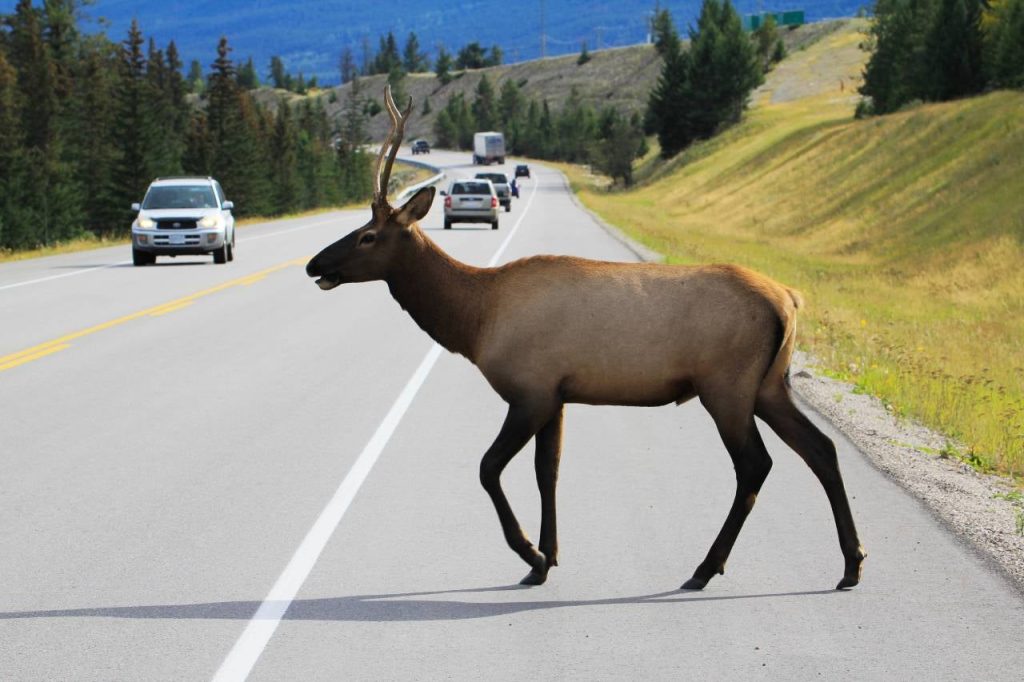Wildlife encounters on American roads aren’t just occasional incidents — they’re a statistical reality for which every driver should be prepared. The latest State Farm analysis reveals U.S. drivers face a 1 in 128 chance of hitting an animal, with over 1.8 million animal-related insurance claims filed between July 2023 and June 2024. Deer remain the most frequently struck animals, with other animals such as dogs, raccoons and coyotes following close behind. Whether you’re navigating high-risk areas like West Virginia (1 in 40 odds) or wondering how your insurance might handle a wildlife collision, Bankrate’s insurance experts will help walk you through everything you need to know about protecting yourself and your vehicle on the road.
Bankrate insights
- A full coverage car insurance policy will typically cover animal-related damage, including collisions. However, if you swerve to avoid an animal and get into a wreck, your insurer could deem you at-fault for the accident.
- On average, a collision with a deer will result in $1,840 in vehicle repairs and $2,702 in medical expenses. (Federal Highway Administration)
- In 2022, there were a total of 184 fatalities due to vehicles colliding with animals. (Insurance Institute for Highway Safety)
How car insurance responds to animal-related accidents
To be covered for an animal-related accident, you will need a full coverage car insurance policy. Although full coverage is not an industry-standard term, it typically means that a driver carries comprehensive and collision coverage in addition to their state’s required insurance coverage.
A full coverage policy does not guarantee that you are off the hook for damages. How you collide with an animal, and whether or not the animal was someone’s pet, can change both how your insurer responds to the accident and which coverage will kick in. Some animal collisions may be covered under your comprehensive coverage, while others may require you to rely on the collision or liability arms of your car insurance policy.
Collision with an animal
Imagine a deer dashes out onto the road, you slam into it and crack your front bumper. In this case, the damage will likely be covered by your comprehensive coverage. This particular type of car insurance coverage offers financial protection for events a driver cannot control, such as vehicle theft, flood damage, falling objects and animal collisions. Comprehensive coverage is not required by state law, but if you finance or lease your vehicle, your financial lender will likely require you to carry it.
In this scenario, you would likely need to file a claim, pay your deductible and let your insurer handle the remaining costs. Comprehensive coverage is not to be confused with collision coverage. Collision coverage primarily covers damage that results from hitting another vehicle, a stationary object or a building. Because a deer or other large animal falls outside of these categories, it would be covered by comprehensive coverage.
Swerving a collision with an animal
Let’s look at a different scenario: you swerve off the road to avoid hitting a deer and crash into a fence. In this case, it is up to your insurer to determine if you are at fault. An insurer may conclude that because the swerving maneuver was a choice made by the driver, the driver is at fault for the accident. Regardless of how fault is determined, collision coverage would likely help cover the repair costs if the driver hit a stationary object after swerving to avoid an animal. However, an at-fault accident can seriously impact your car insurance rates. According to rates from Quadrant Information Services, on average, at-fault accidents raise premiums by $840 annually.
A similar question of fault may take place if you slam on the brakes to avoid hitting an animal. While it may not be illegal to stop for an animal in the road, doing so abruptly could cause someone else to rear-end you and your insurer may deem you at-fault for an accident.
If your insurer does not deem you at fault for the accident, it is possible to file a claim under your collision coverage. Keep in mind that filing a claim may also make your car insurance more expensive. Before filing, you may want to get a repair estimate from a trusted mechanic. If the cost to fix your vehicle is close to your deductible, it may be cheaper in the long run to pay out of pocket and avoid a premium surcharge.
Collision with your pet
From an insurance standpoint, your pet is your personal property. While you may think that property damage liability coverage would apply in this case, that is not necessarily true. Property damage liability typically only pertains to damage done to someone else’s property — not your own. If you are at fault for damaging your own property, like if you back into your garage while parking or ding your mailbox when backing out of your driveway, you will most likely not be able to file a claim with your insurance.
Unfortunately, if you injure your pet with your vehicle, you will generally be responsible for the veterinary bills. While your policy may mention pets, they are typically only covered if they are injured while in the car during an accident, and your insurer extends this type of coverage.
Collision with someone else’s pet
Just like how your pet is your property, someone else’s pet is their property. As such, you may rely on your property damage liability coverage to help with veterinary bills if you injure another person’s pet while driving. However, exactly how this plays out will depend on your state’s unique negligence laws. If the pet was off-leash, you might be able to dispute financial responsibility by claiming that the collision was not the result of your negligence.
Risk of animal-vehicle collisions
Remote roadways and nighttime drivers are especially susceptible to wildlife, but the truth is that collisions with animals can and do happen anywhere. Findings from the Federal Highway Administration (FHWA) indicate that around 1 in 20 reported vehicle accidents are animal-vehicle collisions (AVCs). With more drivers on the road and deer populations on an upward trend, the likelihood of hitting an animal on the road has increased by nearly 50 percent.
Accidents involving wildlife
In some states, nearly 90 percent of wildlife-vehicle collisions (WVCs) involve deer, especially white-tailed deer. An accident with a deer is not only frightening, it is also very expensive. In a comprehensive study, the FHWA estimated that a deer collision results in the following amount of damage, on average:
- $1,840 in vehicle repairs
- $2,702 in medical expenses
- $50 in carcass removal expenses
The larger the animal, the larger the repair bill can be. The FHWA estimates that for a collision with an elk, vehicle repairs cost an average of $3,000. A moose collision is even more expensive, with vehicle repairs averaging $4,000.
The size of the animal is an important factor not just in the cost of the resulting damage from the accident, but also in how drivers react. Maneuvering around a smaller animal is significantly easier than trying to swerve around enormous animals like moose or elk, which could increase the likelihood of a collision.
Threatened and endangered species
While over 95 percent of AVCs result in no human injury, these accidents have a significant impact on animal populations — both large and small. A study from the U.S. Department of Transportation (DOT) declares 21 animal species as federally threatened or endangered in the United States by road mortality and other major threats to survival. Some of these species include the Hawaiian goose, desert tortoise, San Joaquin kit fox and California tiger salamander. Especially precarious is the Florida panther, which is also endangered and particularly susceptible to AVCs.
| Type of species | Animals at risk |
|---|---|
| Mammals | Lower Keys marsh rabbit, Key deer, bighorn sheep (peninsular California), San Joaquin kit fox, Canada lynx, ocelot, Florida panther, red wolf |
| Reptiles | American crocodile, desert tortoise, gopher tortoise, Alabama red-bellied turtle, bog turtle, copperbelly water snake, eastern indigo snake |
| Amphibians | California tiger salamander, flatwoods salamander, Houston toad |
| Birds | Audubon’s crested caracara, Hawaiian goose, Florida scrub jay |
Areas most at risk of animal-vehicle collisions
Animal-vehicle collisions are a persistent issue on U.S. roads, with certain states and times of year presenting heightened risks. According to State Farm’s 2023-2024 data, drivers nationwide had a 1 in 128 chance of hitting an animal, resulting in over 1.8 million animal-related insurance claims during the year. Deer lead as the most common cause of animal-vehicle collisions, followed by rodents, dogs, raccoons and coyotes.
However, some key factors that contribute to an area being higher risk include:
Geography and state-specific risks
- West Virginia is the riskiest state, with drivers facing a 1 in 40 chance of hitting an animal — the highest in the U.S. for over a decade.
- Other high-risk states include Montana (1 in 54), Michigan (1 in 59), Pennsylvania (1 in 61) and Wisconsin (1 in 63).
- States with the most claims include Pennsylvania (150,000+ claims), Michigan (131,000) and North Carolina (98,000).
Seasonal patterns
- The likelihood of hitting an animal spikes between October and December, with November being the most dangerous month. These months coincide with deer mating season and migration, which leads to increased activity near roadways.
Road types and conditions
- Rural, two-lane roads present the highest risks, especially in low-light conditions at dawn or dusk when animals are most active.
- Paved roads with lower traffic volumes often see more animal-vehicle collisions because animals are less deterred by human activity.
- State Farm data suggests that between 30 percent and 50 percent of animal-vehicle collisions occur in such settings, with risky behaviors like speeding or phone use increasing collision odds by 23 percent.
States at highest risk of deer collisions
Drivers in some states are far more likely to experience an animal collision. West Virginia has a decade-long streak of topping the list at 1 in 40 odds. The other states that round out the top 10 include:
| Rank | State | Odds |
| #1 | West Virginia | 1 in 40 |
| #2 | Montana | 1 in 54 |
| #3 | Michigan | 1 in 59 |
| #4 | Pennsylvania | 1 in 61 |
| #5 | Wisconsin | 1 in 63 |
| #6 | Mississippi | 1 in 65 |
| #7 | Iowa | 1 in 68 |
| #8 | South Dakota | 1 in 69 |
| #9 | Virginia | 1 in 73 |
| #10 | Rhode Island | 1 in 75 |
How to handle animals on the road
With some AVCs resulting in fatal injuries, there are some things to know in the event you encounter an animal during your travels.
Steps when encountering pets
Deer, moose and elk are not the only four-legged creatures you might spot on the road; pets also account for a growing number of AVCs. If you see a lost pet on the road, find somewhere safe to pull over. Errant pets can easily cause accidents and endanger other cars on the road around you. Speaking softly and gently can help calm a frightened pet.
Regardless of whether or not you are able to safely secure the animal, you should contact the local authorities for help, making sure to note your address or local coordinates of where the animal was last seen. Local authorities can dispatch someone to retrieve the pet until the owner is found.
Under no circumstances should you enter a busy road to try and retrieve a pet. That said, if you are able to safely pull over, there are some items you can keep in your trunk to help you secure a lost or escaped pet:
- Carrier – A spare cat or dog carrier can help you safely and comfortably secure a lost pet you encounter on the road.
- Slip leashes – Slip leashes are a quick and simple means to effectively secure an escaped pet and ensure that the animal isn’t able to slip away and into danger.
- Reflective vest – A reflective vest helps ensure visibility, especially if you have to venture into the roadways during hazardous road conditions, like rain or fog.
- Treats – A few treats can help entice frightened pets and establish trust.
- Blanket – A blanket can warm a trembling, scared pet and protect your car from fur or debris.
Steps when encountering wildlife
If you encounter wildlife on the road, there are a few things you should do to ensure both your safety as well as that of the animal:
- Slow down. Reduce your speed to allow more time for you and the animal to react.
- Make the animal aware. Remember the phrase “deer in headlights” and use a flash of your headlights to startle the deer out of shock.
- Use your horn. A honk of the horn can be an effective way to motivate an animal that needs to move out of the way.
- Do not swerve. When you break your path, you significantly increase the chances of a collision and could carry the blame if there is an accident. Instead, stay the course and allow the animal a chance to move out of the way.
What to do after a collision with an animal
No matter how much care you exercise on the road, collisions with an animal can still happen. If it happens to you, here are a few steps you should take.
- Pull over. If possible, find somewhere outside of the path of traffic where you can safely exit your vehicle. Turn on your hazard lights so you can be seen.
- Check for damages. Confirm the safety of your passengers to ensure no one requires medical attention. Assess the state of your vehicle to determine whether it is safe to drive.
- Call the police. The police may need to file a report if there are damages to your vehicle so you can file an insurance claim with your provider. They can also assist an injured animal, direct traffic and clean up any debris from the collision.
- Contact a wildlife resource. Depending on your state, check for local organizations that you can contact for help with an injured animal.
- Document the incident. Use your camera or phone to take photos of the damage and the scene so you can provide them as evidence to your insurance company.
- Contact your insurance provider. Contact your car insurance company to find out further details regarding your coverage and learn next steps to file a claim. If you have roadside assistance, it will likely come in handy following an animal collision.
Tips to avoid animal-vehicle collisions
To help you avoid AVCs on the road, these tips can help.
- Stay aware. It’s especially important to remain alert at dawn, dusk and after sunset when deer are most active and therefore more likely to wander onto the road.
- Slow down. Speeding can not only greatly increase the likelihood of an accident, but also the severity of one. By slowing down, you give yourself more time to react in case an animal moves into your path.
- Follow posted signs. Animal crossings are established by authorities to warn travelers of high-traffic areas for wildlife. Pay particular attention to the roads when these signs are present.
- Drive slowly. Lower speeds can give you precious seconds you need to react, so drive slowly and always remain aware of your surroundings at all times.
In the meantime, federal, state and local authorities are working to minimize the number of AVCs that occur on U.S. roads each year. The DOT report details 34 different mitigation techniques, including the following:
- Integrated planning efforts
- Wildlife fencing
- Wildlife crossing structures
- Animal detection systems
- Public information and education
In Canada, for example, Alberta’s Banff National Park has shown incredible progress through the construction of 38 wildlife underpasses and six overpasses, all of which have decreased roadkill by an astounding 80 percent.
Resources
If you see a dead animal on the side of the road, contact your local health or sanitation department for cleanup. The Fish and Wildlife Conservation Commission is available 24 hours a day, seven days a week at 1-888-404-3922.
Contact information varies between every city, town and municipality. Our state resource guide can help you find the right organization to help.
Read the full article here









